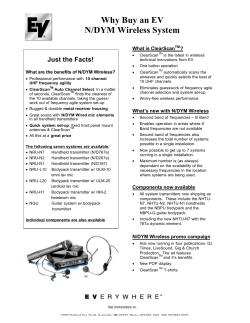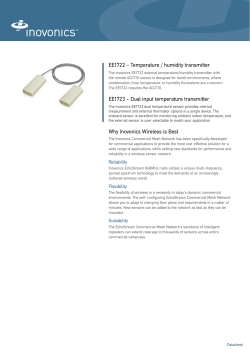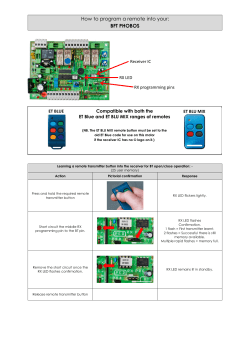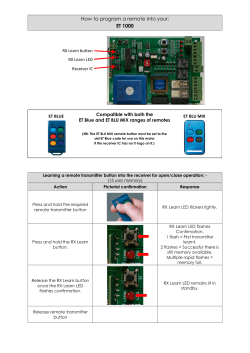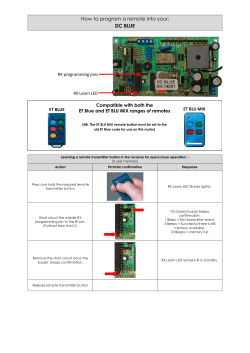
SR: Why Cable Operators need a
SR: Why Cable Operators need a new return path solution today Originally Authored by Peter Wolff, Sep 2012; Amended by Charlie Chen, Jun 2013 Introduction Cable operator’s today face a growing threat from competitors expanding their return path speeds. Generally, today’s North American operators are limited to 5 MHz to 42 MHz in the return path radio frequency spectrum (RF) and a capacity of 100 Mbps using DOCSIS 3.0. Verizon FiOS, recently announced a higher tier data speed of 300 Mbps downstream with 65 Mbps in the upstream. Competitions know that the CATV network is limited to 42 MHz and are starting to offer data rates closer to the 100 Mbps maximum. In a paper by tier one vendors - Cisco, ARRIS, Motorola and Intel recommended the Cable operators moving the return path to DOCSIS 3.1 specifications and perform one node segmentation as a phase one approach. This is key to offering higher tier return rates up to 300 Mbps. With a total capacity of 8 Gbps per 4-way segmented node in the upstream return path, Cable operators now have a 10 year plan that would support the rapid data rate growth. single channel, 5 MHz to 42 MHz where Digital Return are either 2 channels 5 MHz to 42 MHz or 2 channels of 5 MHz to 85 MHz. While Analog Return may easily adapt to a 250 MHz return path, it is not as easy for a Digital Return as its performance is limited by how fast it can sample twice the highest frequency to satisfy Nyquist rates. Higher Digital Return frequency splits mean more costly optics to support the higher data transmission rate over fiber. The approximate calculation for the Optical Transport requirements for a 245 MHz return would be (10 bits per sample * 490 Million Samples / second) * 2 Channels = 9.8 Gbps! Digital Return transmitters would therefore require more costly 10G optics and ADC (analog digital converters). To support the recommended segmentation typically one Analog return transmitter per return segment required and one Digital return path transmitter per two return segments. A second Digital return path transmitter is added to the node if further segmentation is required then. To show how this evolves, Figure 1 depicts a single Analog Return Transmitter used to provide return service. If further segmentation is required, then another return transmitter is needed for each phase disrupting service and adding operational costs. Technical Comparison Cable operators today have had analog and digital solutions for return path transport. Analog transport remains cost effective while Digital Return costs are approaching analog return. However, extending Digital Return to DOCSIS 3.1 at band split of 5-250 MHz would require new, more costly electronics and optics. Today’s Analog return is a Titan Photonics, Inc Figure 1. 1 x 4 Node Segmentation with Analog Return Transmitter White Paper SR Return Path 1 A Digital Return Path solution in Figure 2, whereby a single Return Path Transmitter is used for 2 x 4node segmentation. If further segmentation is required, an additional transmitter is needed or if a band split change is necessary for next generation DOCSIS services then a removal of the transmitter and replacement is necessary again disrupting service and adding operational costs. increases distance in the return path over analog and avoids many non-linear fiber effects In addition to the aforementioned benefits, this unique method would support 4 x 42 MHz, 65 MHz, 85 MHz and 250 MHz spectrum modulated at 256 QAM (quadrature amplitude modulation) levels and segmentation for costs comparable to Analog Return Path Transmission links offered today. This method so-called Sub-Octave Radio Frequency (SR) is offered by Titan Photonics to provide advanced segmentation capability for tomorrow’s networks today. A return path transmitter solution by Titan Photonics depicted in Figure 3 shows a full 4 x4node segmentation using only a single SR Return Path Transmitter. Figure 2. 2 x 4 Node Segmentation with Digital Return Transmitter SR Technology Let us consider a new and advanced approach to the return path that lowers OpEx by: increasing the return channel capacity per wavelength avoiding the use of additional scarce fiber resources lowering power requirements using fewer modules and improved density in the head end lowers per link costs using advanced optical transmission techniques compatible and immediate cost saving to existing DOCSIS 3.0 upgrades provides for future residential or business class DOCSIS 3.1 services using quad 250 MHz return capacity Titan Photonics, Inc Figure 3. SR Return Path Transmitter SR technology offers one optical return path wavelength for four, RF return channels saving fiber and its associated costs. Today demonstrated at 4 times of RF frequency between 5-250MHz, SR is deployed by using an SR Return Path Transmitter and a corresponding SR Return Path Receiver. The Receiver has four RF output ports each providing up to 250 MHz of RF return path spectrum. SR technology employs a patented method to avoid the effects of Chromatic Dispersion normally generating Composite Second Order Distortions White Paper SR Return Path 2 called (CSO) that impact analog transmission. Typically, a single 1 GHz of RF spectrum transported over fiber is composed of multiple octaves of RF spectrum. The SR technique sub-divides the transported spectrum during up-conversion to higher order carrier level and down coverts the transported spectrum back to its original format and content. This technique allows for the rejection of the signals affected by CSO. Costs reduced by avoiding the use of expensive A/D and D/A converters and normally used distributed feedback lasers. Titan’s SR technology provides high performance while overcoming the limitations of the use of lower cost laser diodes. Today SR has demonstrated a 35 dB noise power ratio (NPR) over a 20 dB RF signal range at 256 QAM and a 5-250 MHz upstream spectrum window. See Figure 4 to review the NPR and Bit Error Rate curves. If plant conditions grow to use 1024 QAM, Titan’s SR has capability to achieve that modulation level as well. If operators decide to use an erbium doped fiber amplifier in conjunction with transmissions in the ITU C band (1550 nanometer light wave window), SR Return Path products are plausible at long links beyond the 60km distance. The table below highlights the superior value proposition for the SR Return path technology. Lowest cost for SR is a significant standout if one calculates a normalized cost ratio based on $x per link for an equivalent Analog solution and then divides by the available spectrum the technology is capable of transporting. While link distance is a stand out for Digital return, SR is certainly capable of meeting the needs of the majority of networks deployed today with a typical link distance of 60 km. Analog return transmitters are capable of transmitting beyond 250 MHz, but are bandwidth limited at the existing receiver to 200 MHz. Digital return will continue to be limited by the rate at which manufacturers can increase the sampling rates of A/D and D/A converters. It is likely that it may be years before it is possible to transport one or two channels of 250 MHz spectrum. SR Return path technology is available today providing the means to offer advanced service capabilities to operators as they drive to increase new revenue streams. Analog Digital Titan SR Equipment (Cap-Ex) Cost/Spectrum (MHz) Medium x High 1.25x Very Low 0.2x Link Distance (km) Low 20km Very High 100km > High 100km Operating Pass band (MHz) Medium 5-42, 250 Low 2 x 5-42 High 4 x 5-250 Future Proof No No Yes Figure 4. QUAD CH1 BER Test under 250 MHz noise loading, +8dBm, 20 km Titan Photonics, Inc White Paper SR Return Path 3 Summary References Next generation DOCSIS 3.1 will provide tremendous opportunities for operators to continue competing with Telcos in offering new services. This is going to require some advances in the return path spectrum and solutions that keep CapEx and OpEx costs lower. Operators segmenting nodes and considering new return path solutions should evaluate their future needs as they make purchase decisions today. SR Return Path solutions by Titan Photonics provide a unique strategy to continue to leverage the existing DOCSIS infrastructure while offering increased data rates, lower costs, low power and fiber savings over alternatives in the market today. http://www.cedmagazine.com/articles/2012/07/an -evolutionary-approach-to-gigabit-class-docsis Titan Photonics, Inc http://www22.verizon.com/home/fios-fastestinternet/fastest-internet-plans/ Contact Us Titan Photonics, Inc. 48501 Warm Springs Blvd #106, Fremont, CA 94539, USA Phone: (510) 687-0488 Email: sales@titanphotonics.com Website: www.titanphotonics.com White Paper SR Return Path 4
© Copyright 2025









